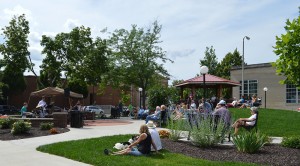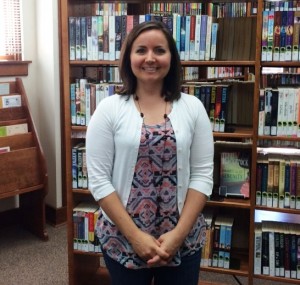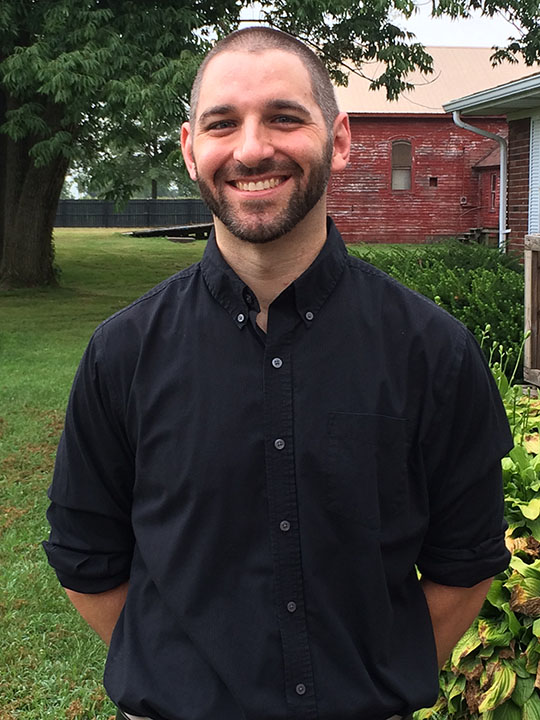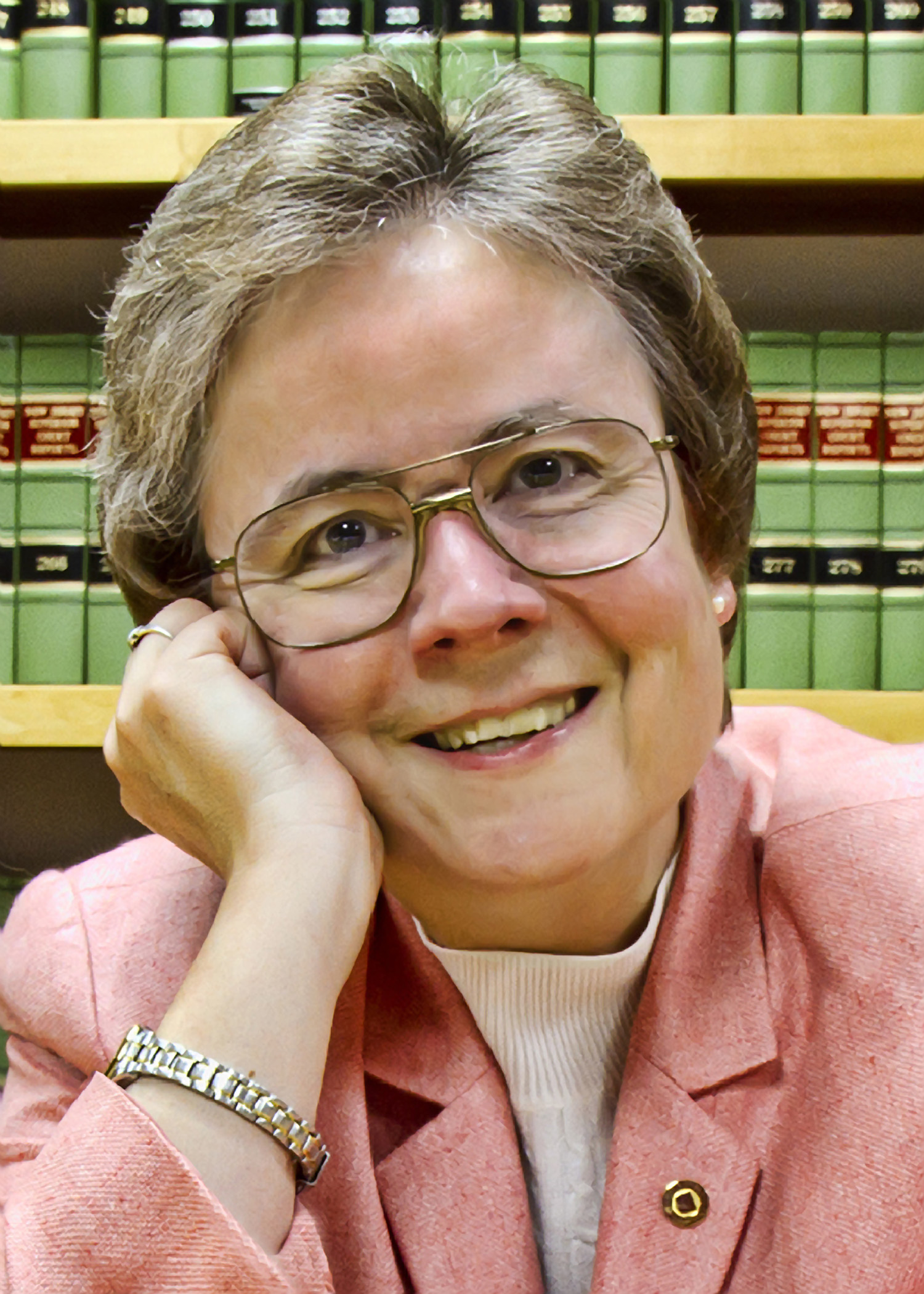I recently interviewed Adams Public Library Systems Administrator Rich Weiland about the new and exciting ‘Hot Spot’ program at his library. Below is the highlights from our interview.
Category Archives: Professional Development Office (PDO)
An Interview with Adams Public Library System Director Kelly Ehinger
Kelly was one of the first directors I visited in my region; the first one to invite me to the Adams Public Library “Staff Day” and the first presentation I gave in my job as the North East Regional Coordinator! I loved visiting Adams Public Library System and seeing their innovative technology – the whole staff was building mini computers the day I presented (Kano kits), and they had a huge portable white board I used for giving my presentation on INSPIRE. I also absolutely loved their Storybook Corner – an awesome outdoor space to hold all sorts of library and community events!
PAULA: Are you from the area? If not, where are you from originally?
KELLY: I am a native Hoosier from Anderson originally, but I moved to Maine for a few years as a university librarian before returning to Indiana in 1997 as the Decatur Public Library director. [Decatur prior to the 2008 consolidation]
1,000 Books Before Kindergarten
 I recently visited with Heather Barron, Director of the Bourbon Public Library. Bourbon Public Library is a lively branch bustling with activities. During the visit, I chatted with Heather about the library and the unique challenges and opportunities of working in a small branch; while talking, I found out about a wonderful program, 1000 books before kindergarten that they are involved with. This program helps to establish reading habits and comprehension for young readers. Continue reading
I recently visited with Heather Barron, Director of the Bourbon Public Library. Bourbon Public Library is a lively branch bustling with activities. During the visit, I chatted with Heather about the library and the unique challenges and opportunities of working in a small branch; while talking, I found out about a wonderful program, 1000 books before kindergarten that they are involved with. This program helps to establish reading habits and comprehension for young readers. Continue reading
An Interview with Sullivan County Public Library Director Jordan Orwig
I recently had the opportunity to visit the Sullivan County Public library and meet new director, Jordan Orwig. He was kind enough to allow me to interview him for the library blog.  Are you from the area? If not, where are you from originally?
Are you from the area? If not, where are you from originally?
Yes, I have lived in Sullivan my entire life except for a short stint as a college student at Indiana University in Bloomington, IN. Living in another town was a great experience, but it was nice to move back home, get involved, and reinvest in the town where I grew up.
When I was a child my parents actually looked into buying the house that currently houses the library administration offices. Obviously they didn’t purchase it, but it seems like one way or another I was always meant to be in it.
What inspired you to work in libraries?
Books and reading have been passions for me for as long as I can remember. After college, I started working at a local newspaper. I was there for a number of years, and then I heard about the possibility of a job opening at the library. After looking into getting my MLS, everything just seemed to click. The Sullivan County Public Library was actually my first employer, too. I worked as a page all through high school, so I think it’s fitting that I get to come back to the same library where I entered the working world.
What is your favorite thing about working for your library?
Besides being surrounded by books every day? I am involved in a number of organizations that serve our community. Working at the library is just one more opportunity that I can utilize to make the county I grew up in a better place. I love the fact that libraries can mean different things to different people. While one person might come in to check out books every week, someone else might only come in once to send in a job application. It’s humbling to consider that the library can help people on many different levels.
What is your favorite book?
Perdido Street Station by China Miéville It was actually assigned to my wife in one of her college courses in 2008. I’d never heard of the guy, but she thought that I’d like it since I was into sci-fi and fantasy, so she gave it to me after the class wrapped up. I fell in love with everything about it immediately. I am not exaggerating when I say that it changed my life and changed how and what I read. Ever since then, I’ve read almost everything he’s written and haven’t shut up about him.
If you could have dinner with any three famous people in recorded history, who would they be and why?
I would be lying if I didn’t include the aforementioned Miéville in that group. I think my answer above should explain why. The other two would have to be Andrew Carnegie and Matthew McConaughey. Carnegie because – come on, this is a library blog, I pretty much have to pick him! In all seriousness though, I’d love to hear his thoughts about his affect on this nation and its libraries. I’d pick McConaughey because of an interview I heard with him on NPR’s Fresh Air program. He’s definitely a guy who knows who he is, where he came from, and what his place is in the world. If you haven’t listened to it, go check it out and I bet you’ll want to meet him, too.
What do you enjoy doing when you’re not at work?
My wife and I are pretty avid bicyclers. We also discovered obstacle course racing this year and have already completed a Tough Mudder, with several other races planned yet this year. They are absolutely insane, fun, and worth trying. I have also played bass in a band with my wife and friend for about two years now. We play country music, but faster and louder than what you usually hear on the radio.
This blog post was written by Amber Painter, Outreach Librarian. For more information, contact the Professional Development Office at (317) 232-3697 or email statewideservices@library.in.gov.
An Interview with Jay County Public Library Director Eric Hinderliter
I visited Eric Hinderliter recently at the Jay County Public Library in Portland, Indiana and was very impressed with what Eric and his staff are doing in Jay County! The staff has a wonderful team spirit – they bonded when their library was flooded in 2014 from a water heater break and have come together to create a new Summer Challenge for all ages.
PN: Are you from the area? If not, where are you from originally?
EH: No, I am originally from Ada, Ohio, which is located off I-75 close to Lima. Marriage turned me into a Hoosier, but I still prefer to root for Ohio State.
PN: What inspired you to work in libraries?
EH: I had no thoughts at all about working in a library before I started my first library job in Van Buren. I was a high school social studies teacher and owned a lawn care business and a restaurant before moving into the library field. Van Buren happened to need a director, I happened to need a job, and I lived in Van Buren. The rest is history.
PN: What is your favorite thing about working for your library?
EH: I like the fact that I have an opportunity each day to work with a group of people to make a difference in Jay County. Continue reading
ALA San Francisco Recap
The 2015 ALA annual conference #alaaac15 has come and gone and it was another memorable one for the books – literally and figuratively. If you have ever experienced this conference before, you know that some of the battle is getting back home without picking up too many Advanced Readers Copies of books. For bibliomaniacs everywhere, the struggle is real. I try to resist, having purposefully packed only a small carry-on, yet alas ended up shipping 2 boxes of books back anyway. Yay, books!

I was fortunate to be able to garner support and go to the annual conference this year, only having a few months under my belt as Children’s Services Consultant at the Indiana State Library. With a new city to navigate and different sessions from which to learn, it’s definitely a whirlwind and one you have to plan ahead of time. The ALA conference website has a nice online scheduler to assist you with jam-packing your days with high-conflict/high-priority sessions. Whee! Most times, though you’ve planned, you still roll with the punches – seeing how you feel (“I need coffee!”) and where you are actually located to see if it’s feasible to attend the session you wished. And, of course, you HAVE to compare your session times against all the great author signings in the exhibit halls.
Library Budgets
Starting in early July, 237 Indiana public libraries plan a budget. This will tell how the library spends money in the next calendar year. Library expenses are for services such as staff, materials, facilities and technology. These services are determined by the library community goals as outlined in their strategic plan.
Libraries in Indiana can levy a tax that results in revenue from property tax; the other money is received from miscellaneous tax such as sales tax, some local income tax, and revenue the library generates itself through fines and fees.
There are two authorities that oversee the library and its budget plan: the library board, and The Department of Local Government Finance (DLGF), a state agency. Each year the budget can grow according to a growth quotient, a number that is calculated from federal data based on the growth of personal income. The DLGF issues the growth quotient and the library board calculates the budget with input from library director. The budget estimate with the calculation results in a levy and a tax.
The budget approval process follows the budget calendar. First the public is given notice through two advertisements in September, then a public hearing is held for the plans approval by the library board. After approval, the plan is submitted to the DLGF by November 2. The budget order is issued in the New Year by the DLGF.
The public can see library budgets on the public side of the Budget Gateway found here https://gateway.ifionline.org/default.aspx. Click on the link to view local budgets. Then select report, for example, select “Budget Estimate-Financial Statement-Tax Rate.” On this page you make several selections. Choose a county, unit (library) and the name of the unit. You can choose from the fund types available to see the budgets. The report gives the total budget estimate, the tax rate and the tax levy.
The public libraries work as good stewards to safeguard the money, monitor the cash flow, and provide the community with excellent library services.
For more information, view an eight minute video on “Public Library Budgeting in Indiana” found on the webpage http://www.in.gov/library/5416.htm. This presentation is a budget primer for library staff and patrons.
This blog post was written by Karen Ainslie, Library Development Librarian and Professional Development Office Librarian. For more information, contact the Library Development Office at (317) 232-3697 or email statewideservices@library.in.gov.
Genealogy Librarians and Professional Development
Professional development is an important part of librarianship, so that librarians can keep up with innovations within the profession and thus provide the best possible service to the public. This is particularly important in specialized subject such as genealogy. With that in mind, two librarians from the Genealogy Division of the Indiana State Library attended the Indiana Genealogical Society’s (IGS) annual conference at Indiana State University earlier this year, where they attended several presentations by Judy Russell, author of the popular blog The Legal Genealogist. Russell’s lectures were both informative and entertaining. She spoke on visiting county courthouses for genealogical research in original county records, finding ancestors’ military and military pension records and the abundant genealogical information they can contain, and tracking our “black sheep” ancestors using court and prison records as well as other contemporary sources, such as newspaper articles.

If you were unable to attend the IGS conference or if you would like to hear Judy Russell again, she will be speaking at the annual Genealogy and Local History Fair held at the Indiana State Library on October 24, 2015. Russell will be speaking on research methods for finding your “black sheep” ancestors and utilizing underused collections, such as prison records, to further that research. This free event is open to the public and registration is not required.
For those in the library or legal professions, these sessions have been approved for LEUs and CLEs.
This blog post was written by Crystal Ward, Genealogy Librarian, Indiana State Library. For more information, contact the Indiana State Library at (317)232-3678 or “Ask-A-Librarian” at http://www.in.gov/library/ask.htm
Indiana’s Library Makers
PDO is in the process of creating a comprehensive map of library makers throughout the state of Indiana. It is no secret that many libraries in the state have already embraced maker culture. Unfortunately, there is currently no comprehensive list of these libraries in the state. Our goal for the map is to create a resource that will highlight libraries that have embraced maker culture, and to facilitate communication and resource sharing among libraries. The map will allow users to select specific institutions and learn about the resources and programs that they offer.
Map Key: Libraries with designated maker spaces are in red. Libraries with maker equipment are in dark grey
What is a makerspace?
A makerspace is a physical location where people gather to share resources and knowledge, work on projects, network, and build. Within libraries this can be anything from a digital creativity studio to an area that is designated for patrons to bring in their own projects to work on.
Who is a maker?
A maker can be anyone who demonstrates an interest in DIY culture. Although a lot of attention is given to makers who work with science, technology, engineering, or math; a maker can be anyone who embraces DIY culture as a hobby or a full-time job.
Why should libraries embrace maker culture?
- Heightened motivation and new forms of engagement through meaningful play and experimentation.
- Learning that feels relevant to patrons’ identities and interests.
- Opportunities for creating using a variety of media, tools, and practices.
- Co-configured expertise where educators and students pool their skills and knowledge and share in tasks of teaching and learning.
- An integrated system of learning where connections between home, school, community and world are enabled and encouraged.
In the future…
Later in the summer, PDO will open a survey to learn how libraries are embracing maker culture within their own organization. This survey will also help us to identify libraries with designated maker spaces as well as those libraries who are currently embracing maker culture and technologies. As we collect information on libraries who have embraced maker culture, we will add their location and offerings to the Maker map. The results of the survey and final version of the maker map will be released at the ILF annual in November.
This blog post was written by Amber Painter, Professional Development Librarian. For more information, contact the Professional Development Office at (317) 232-3697 or email statewideservices@library.in.gov.
Professional Development at Your Fingertips
Looking to brush up customer service skills? Wondering about current trends in the library world? There are lots of professional development and continuing education opportunities around that are available to Indiana users online.
- Lyrasis – Using Lyrasis is easy and allows access to many quality trainings. Trainings are already paid for by the Indiana State Library (ISL) so library staff can be assured that they are free. Simply browse their offerings, choose a training, apply for a Promo Code if needed (classes that do not list a cost do not require a Promo Code) register, and attend the class. Pro Tip: If you don’t have time to take the class when it’s offered, register anyway. After the class is offered you will be emailed an access link and you can take the class at your leisure.
- Lynda.com – With tutorials for dozens of topics, Lynda.com can help library staff learn to take better pictures for their FaceBook page, discover better ways to lead, and learn tips on how to use WordPress. To gain access, just fill out the Lynda.com Course Application Form. You will receive your username and password in your email. Pro Tip: If you’ve forgotten whether or not you have already logged in, try to log in with your email address. Forgot your password? It’s easy to reset through the prompts on the page.
- Free Webinars – The Indiana State Library keeps an ongoing and updated spreadsheet of pre-approved webinar courses. In a simple excel format, these are arranged by date and cover a variety of topics. Pro Tip: Don’t forget, someone in your own organization can create your LEU Certificate in-house. Check out our policy on LEUs for Live and Archived Webinars.
- Pre Approved Providers – The ISL also keeps a list of organizations who present webinars that are pre-approved for LEUs. This is so great because staff can be assured that any webinar offered by these providers is a go for LEUs. The only stipulation is that courses must be at least 30 minutes in length to count for 1 LEU.
Pro Tip: Courses that are 30-90 minutes of content are equivalent to 1 LEU. - ISL’s Calendar of Events – The ISL also hosts our own webinars as well as other face-to-face trainings. The are listed on our calendar and are open to all library staff. Pro Tip: Registration for webinars is usually done through an internal link on the calendar. Just click on the training title and then click on the Event Registration Page in order to register.
This blog post was written by Suzanne Walker, Professional Development Office Supervisor. For more information, contact the Professional Development Office at (317) 232-3697 or email statewideservices@library.in.gov.
